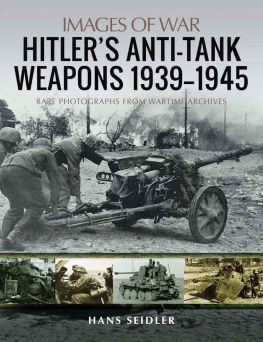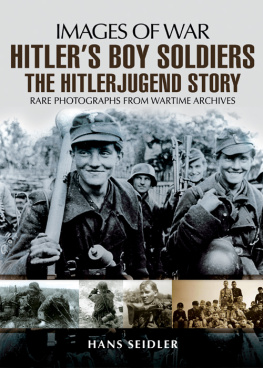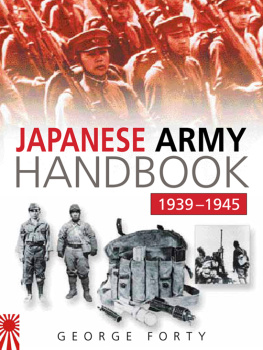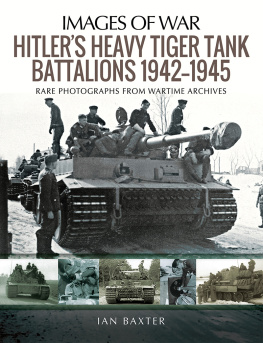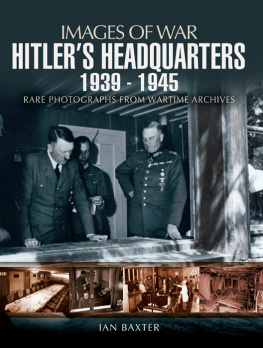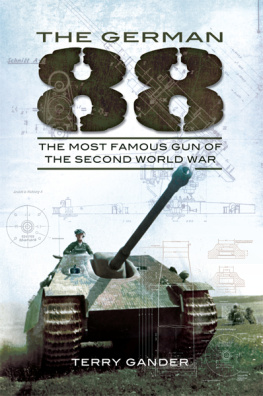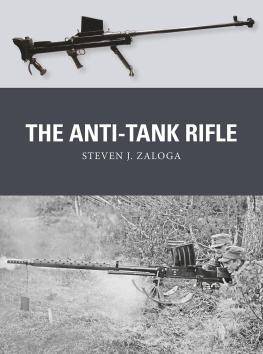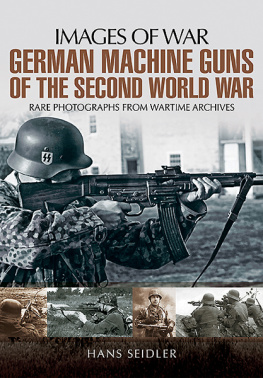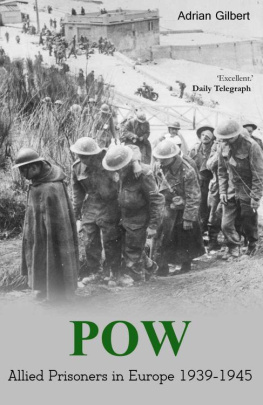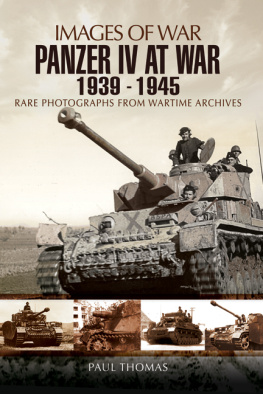Seidler Hans - Hitlers Anti-Tank Weapons 1939-1945
Here you can read online Seidler Hans - Hitlers Anti-Tank Weapons 1939-1945 full text of the book (entire story) in english for free. Download pdf and epub, get meaning, cover and reviews about this ebook. year: 2020, publisher: Pen & Sword Books Limited, genre: Non-fiction. Description of the work, (preface) as well as reviews are available. Best literature library LitArk.com created for fans of good reading and offers a wide selection of genres:
Romance novel
Science fiction
Adventure
Detective
Science
History
Home and family
Prose
Art
Politics
Computer
Non-fiction
Religion
Business
Children
Humor
Choose a favorite category and find really read worthwhile books. Enjoy immersion in the world of imagination, feel the emotions of the characters or learn something new for yourself, make an fascinating discovery.
- Book:Hitlers Anti-Tank Weapons 1939-1945
- Author:
- Publisher:Pen & Sword Books Limited
- Genre:
- Year:2020
- Rating:4 / 5
- Favourites:Add to favourites
- Your mark:
- 80
- 1
- 2
- 3
- 4
- 5
Hitlers Anti-Tank Weapons 1939-1945: summary, description and annotation
We offer to read an annotation, description, summary or preface (depends on what the author of the book "Hitlers Anti-Tank Weapons 1939-1945" wrote himself). If you haven't found the necessary information about the book — write in the comments, we will try to find it.
Hitlers Anti-Tank Weapons 1939-1945 — read online for free the complete book (whole text) full work
Below is the text of the book, divided by pages. System saving the place of the last page read, allows you to conveniently read the book "Hitlers Anti-Tank Weapons 1939-1945" online for free, without having to search again every time where you left off. Put a bookmark, and you can go to the page where you finished reading at any time.
Font size:
Interval:
Bookmark:

IMAGES OF WAR
RARE PHOTOGRAPHS FROM WARTIME ARCHIVES
Hans Seidler

First published in Great Britain in 2020 by
PEN & SWORD MILITARY
An imprint of
Pen & Sword Books Ltd
47 Church Street
Barnsley
South Yorkshire
S70 2AS
Copyright Hans Seidler, 2020
ISBN 978-1-52674-983-3
eISBN 978-1-52674-984-0
Mobi ISBN 978-1-52674985-7
The right of Hans Seidler to be identified as author of this work has been asserted by him in accordance with the Copyright, Designs and Patents Act 1988.
A CIP catalogue record for this book is available from the British Library.
All rights reserved. No part of this book may be reproduced or transmitted in any form or by any means, electronic or mechanical including photocopying, recording or by any information storage and retrieval system, without permission from the Publisher in writing.
Pen & Sword Books Limited incorporates the imprints of Atlas, Archaeology, Aviation, Discovery, Family History, Fiction, History, Maritime, Military, Military Classics, Politics, Select, Transport, True Crime, Air World, Frontline Publishing, Leo Cooper, Remember When, Seaforth Publishing, The Praetorian Press, Wharncliffe Local History, Wharncliffe Transport, Wharncliffe True Crime and White Owl.
For a complete list of Pen & Sword titles please contact
PEN & SWORD BOOKS LIMITED
47 Church Street, Barnsley, South Yorkshire S70 2AS, England
E-mail:
Website: www.pen-and-sword.co.uk
A n anti-tank gun is an artillery weapon primarily designed to destroy armoured fighting vehicles, normally from a fixed defensive position. The Germans were masters of anti-tank gun warfare, and during the Second World War developed a variety of specialised anti-tank munitions and anti-tank guns. This book, in the popular Images of War series, is dedicated to the men and the guns that fought in the anti-tank war. With rare and unpublished photographs, accompanied by detailed captions and text, the book covers all the various PaK guns from the 3.7cm PaK 35, 5cm PaK 38 and the 7.5cm PaK 40, to the versatile 8.8cm FlaK guns, and the vehicles that pulled these weapons including the specialised forward observers and reconnaissance elements.
As the war progressed, the ever increasing demands on the German war machine required drastic changes in anti-tank warfare. This included mounting PaK guns on halftracks and converted Panzers and turning them into fast mobile tank-killing machines or Panzerjager (Panzer hunters). This led to further development in anti-tank guns, and to more economical weapons that were deadly and efficient such as the hand-held anti-tank weapons including the Panzerfaust and Panzerschrek, which were used in all the theatres of war. The Panzerfaust was used extensively in the last year of the war, and with its unique shaped-charge warhead could penetrate the armour of any fighting vehicle. After firing, the tube was discarded, making the Panzerfaust the first disposable anti-tank weapon in history.
This book provides a unique overview of German anti-tank gun warfare from action in Poland, the Low Countries, France, Italy, and the Eastern Front, up to the last weeks of the war. This highly illustrated record of the firepower of the Nazi war machine is a must for anyone interested in weapons of war.
W ith the introduction of thicker-armoured heavier tanks being manufactured around the world, German weapon designers in the 1930s worked to produce a light weapon that could be towed, moved, concealed easily and with the fire power to deal with enemy tanks if the country was ever to go to war. As a result of this, anti-tank weapons, or Panzer Abwehr Kanone (PaK for short), were designed and manufactured. Just as important was that these guns possessed a projectile with high velocity ammunition that could pierce enemy tanks at a reasonable range and halt their progress on the battlefield.
When war finally broke out in September 1939 and Germany invaded Poland, the attack was a surprise for the Polish enemy. While bombers and fighter planes soared overhead, reconnoitring, attacking, spreading fire and fear, Panzers, whole divisions of them, sped across the countryside, accompanied by infantry of 1.5 million men on horses and in motorized columns. Among this arsenal were the anti-tank PaK units.
It was here that the Germans introduced their first anti-tank gun, the 3.7cm PaK 35/36. This was the standard German anti-tank gun at the outbreak of war. By design standards it was small but rugged, well-engineered and reliable. The gun was of conventional type and was carried on a two-wheel split-rail carriage of tubular construction with a bolted-on sloped armoured shield. A hydro spring recoil system was carried in the cradle and the wheels had coiled springs.
During the invasion of Poland the Germans fielded some 11,200 of these guns, and the gun proved more than adequate against lightly armoured opposition in spite of having a disappointing penetrative performance. Many of the PaK units were towed by animals, and while this mode of transport was relatively slow, resistance was not a major threat and PaK units had considerable freedom of movement on the battlefield without much danger of being overrun.
The Germans also had a small number of anti-tank rifles. These dated back to the First World War with the Mauser 1918 T-Gewehr, the worlds first anti-tank rifle, created in response to the appearance of British tanks on the Western Front. By the 1930s development resumed in an effort to provide infantry with a man-portable lightweight anti-tank rifle. First produced was the Panzerbchse 38 (PzB 38). Only a small number were built in 1939 with sixty-two used by German troops in Poland. A modified version of this anti-tank rifle also saw action in Poland that September, the Panzerbchse 39 (PzB 39). The weapon was virtually identical to the PzB 38 but slightly longer and lighter. Performance was basically the same as that of the PzB 38, and 568 were used by the German army in the invasion of Poland. Success rate against lightly armed Polish opposition saw the Panzerbchse make a number of successful engagements, but it was still far from adequate against heavier armoured-plated vehicles.
Following Polands defeat in early October 1939, plans were soon drawn up to attack the Low Countries and France. For the attack, and to support a typical German division during its advance, there was now the anti-tank battalion, which contained a heavy MG34 machine gun company equipped with twelve 2cm FlaK; and three anti-tank gun companies, each equipped with twelve 3.7.cm PaK 35/36 guns. Also there was a single company of ten 8.8cm FlaK 18 auf Zugkraftwagen. These 8.8cm flak guns were mounted on the chassis of an armoured Sd.Kfz.7 half-track to oppose the thickly armoured British Matilda and French Char B tanks.
While the attack in the West was a complete success, PaK crews quickly learnt how inadequate the PaK 35/36 gun was against the French and British heavy tanks. The enemy were able to defend their positions longer and score a number of sizable successes, much to the frustration of the Germans. It was still effective against the most common light tanks, such as the French R35; and the Char Bs and Matildas represented but a small part of the total number of armoured vehicles in operation in the West; but it clearly needed improvement.
Font size:
Interval:
Bookmark:
Similar books «Hitlers Anti-Tank Weapons 1939-1945»
Look at similar books to Hitlers Anti-Tank Weapons 1939-1945. We have selected literature similar in name and meaning in the hope of providing readers with more options to find new, interesting, not yet read works.
Discussion, reviews of the book Hitlers Anti-Tank Weapons 1939-1945 and just readers' own opinions. Leave your comments, write what you think about the work, its meaning or the main characters. Specify what exactly you liked and what you didn't like, and why you think so.

